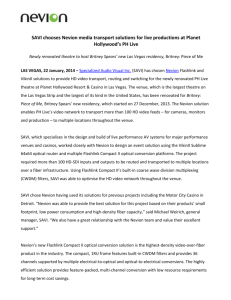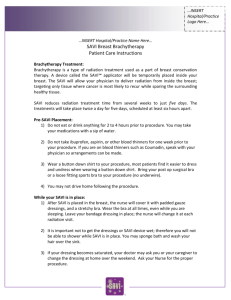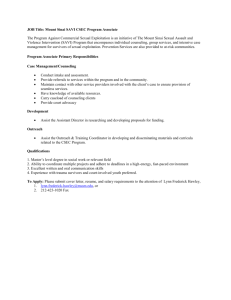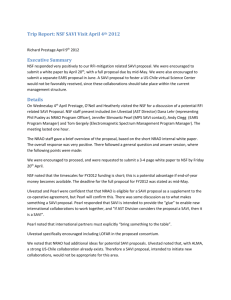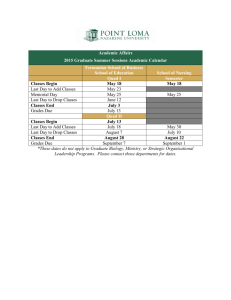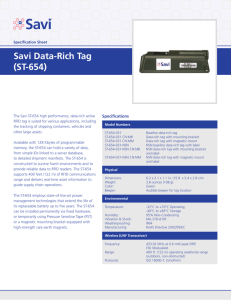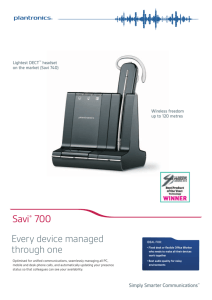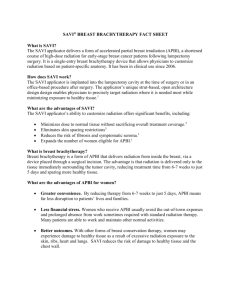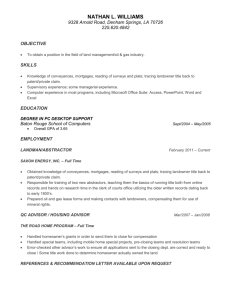Quad Wants To Be a Savi Player In Agribusiness Introduction
advertisement
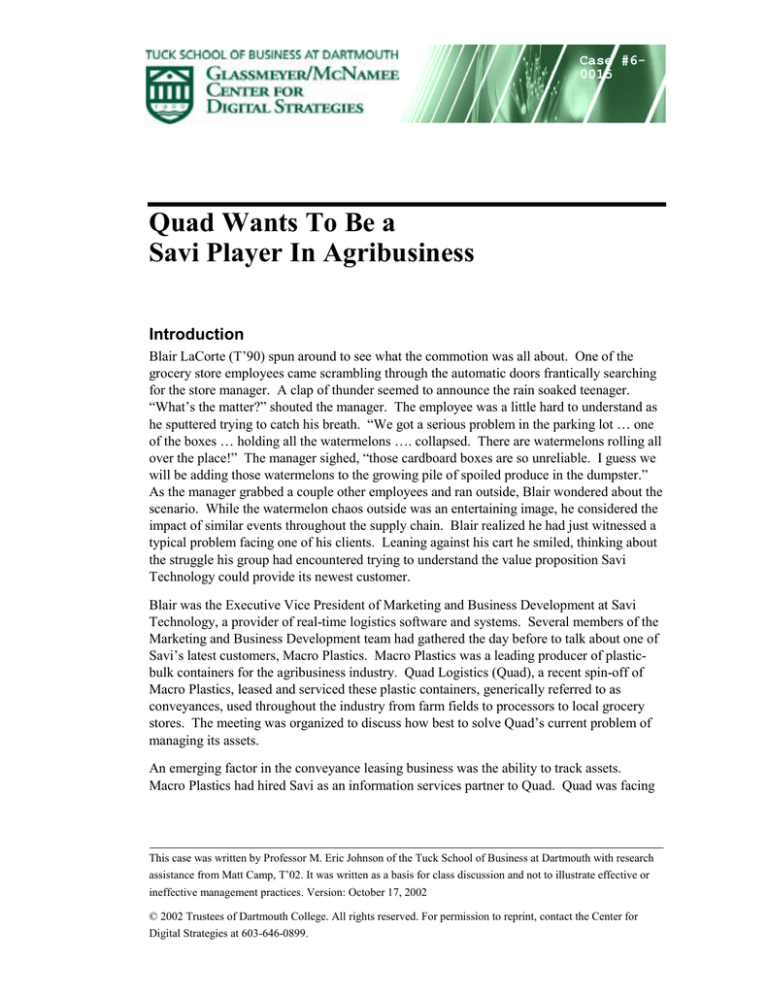
Case #60015 Quad Wants To Be a Savi Player In Agribusiness Introduction Blair LaCorte (T’90) spun around to see what the commotion was all about. One of the grocery store employees came scrambling through the automatic doors frantically searching for the store manager. A clap of thunder seemed to announce the rain soaked teenager. “What’s the matter?” shouted the manager. The employee was a little hard to understand as he sputtered trying to catch his breath. “We got a serious problem in the parking lot … one of the boxes … holding all the watermelons …. collapsed. There are watermelons rolling all over the place!” The manager sighed, “those cardboard boxes are so unreliable. I guess we will be adding those watermelons to the growing pile of spoiled produce in the dumpster.” As the manager grabbed a couple other employees and ran outside, Blair wondered about the scenario. While the watermelon chaos outside was an entertaining image, he considered the impact of similar events throughout the supply chain. Blair realized he had just witnessed a typical problem facing one of his clients. Leaning against his cart he smiled, thinking about the struggle his group had encountered trying to understand the value proposition Savi Technology could provide its newest customer. Blair was the Executive Vice President of Marketing and Business Development at Savi Technology, a provider of real-time logistics software and systems. Several members of the Marketing and Business Development team had gathered the day before to talk about one of Savi’s latest customers, Macro Plastics. Macro Plastics was a leading producer of plasticbulk containers for the agribusiness industry. Quad Logistics (Quad), a recent spin-off of Macro Plastics, leased and serviced these plastic containers, generically referred to as conveyances, used throughout the industry from farm fields to processors to local grocery stores. The meeting was organized to discuss how best to solve Quad’s current problem of managing its assets. An emerging factor in the conveyance leasing business was the ability to track assets. Macro Plastics had hired Savi as an information services partner to Quad. Quad was facing This case was written by Professor M. Eric Johnson of the Tuck School of Business at Dartmouth with research assistance from Matt Camp, T’02. It was written as a basis for class discussion and not to illustrate effective or ineffective management practices. Version: October 17, 2002 © 2002 Trustees of Dartmouth College. All rights reserved. For permission to reprint, contact the Center for Digital Strategies at 603-646-0899. Savi no. 6-0015 several different issues. First, it was having a hard time tracking the conveyances it leased. Due to the multiple players in the supply chain, it was hard to know where each conveyance was at any particular time. This led to several problems. Once it left Quad, there was no guarantee that it would ever come back. Also, if the conveyance got damaged, it was hard to assign responsibility to anyone. Plus, it was difficult to reconcile with customers if there had been a delivery mix-up - there was little proof that a certain amount of conveyances were shipped or received. Second, reusable plastic containers (RPC) had not become the de-facto standard for the farm-to-retail industry. There was an adversarial relationship present between growershippers, packaging supply companies, and retailers over this issue. Each side had their own opinions why certain containers worked better than others. According to a recent study done by industry consultancy1, growers and shippers of the fragmented produce industry basically were satisfied with corrugated paperboard. Any switch to RPCs would have to be initiated by their major customers – retail grocery chains. In the long run, both RPCs and corrugated paperboard would be likely to share the market.2 Retailers, on the other hand, were starting to transition towards the RPCs. A third issue involved Quad’s competitive advantage. Quad was looking for a point of differentiation in the commoditized plastic container business. Asset tracking offered a value-added benefit for consumers to gain visibility into the supply chain including transportation times, delays, and storage times. Quad wanted to be one of the pioneers to offer the latest technology in food logistics visibility to their clients. Quad had initiated a pilot project with Savi to track conveyances in the central California growing region. To move beyond the pilot, Savi needed to show Quad that a large-scale rollout was technically feasible and provided a high return for Quad. The meeting to discuss Savi’s value proposition for Quad had lasted longer than anticipated with most of the discussion revolving around some of the recent developments in Savi’s software and engineering. Unfortunately, Quad’s specific needs weren’t being discussed in depth. Finally, Rohit Verma, Director of Strategy for Savi, summarized the key points: “For Quad, it essentially comes down to identifying the four main cost areas – utilization, loss/replacement, labor, and repositioning of conveyances. What are these costs under the current inventory management system? Once we have identified these costs, we look at the areas where Savi can reduce or eliminate the costs. Utilization: How much of their fleet is not circulating through the system on a regular basis? Loss/Replacement: When is a conveyance considered lost and who was the last to have it? Labor: How many hours are allocated to the manual recording and reconciling of conveyances? Repositioning: What’s the current cost of having to move conveyances from one customer to another due to poor planning 1 Bottom Line Consulting, 1998. 2 Source: Carney & Fearncombe, Resource Recycling, October 1998 (www.plasticsresource.com) Tuck School of Business at Dartmouth—Glassmeyer/McNamee Center for Digital Strategies 2 Savi no. 6-0015 and miscommunication? Using our Conveyance Management System, Quad will be able to track their conveyances and answer these questions and others.” Lance Trebesch, Savi’s VP of Business Development, interjected: “There’s no question that Quad and its customers will benefit from our technology. But, right now, they’re skeptical. Because Quad is brand new, there aren’t any “before Savi” data points to which we can compare. Plus, there’s some confusion over the validity of the data being captured. In order for us to convince them to extend our contract beyond this pilot integration, we really need to demonstrate to them a convincing value proposition.” Before Rohit could respond, Blair jumped in: “Lance’s right, but so is Rohit. We need to take it a step further, though. The key to our success on this, and future contracts, is to show a value proposition for our customer and Quad’s customers. For instance, by using Quad, a retailer will have visibility into a conveyance’s journey and duration of trip from the grower. As a result, he should have a better idea of his shrink and spoilage costs. That will convince the retailer to go with Quad and Quad to stick with us. Let’s get to work on that value proposition.” Savi Technology The idea behind Savi occurred to founder Rob Reis in one of life’s panics. Shopping in a large bay-area grocery store one Saturday morning, Rob’s toddler son wondered off. Frantically searching the store aisles for the missing boy, Rob wished his son had some sort of electronic device on his clothing that could be used to track his position in the store. After finding his son, stationed in the toy aisle, Rob kept thinking about his idea. On Monday he shared his idea for the “tagalong” device, which would use Radio Frequency Identification (RFID), with fellow Stanford engineering graduate student, Vic Verma. Rob continued working on the idea, founding Savi in 1989 to develop RFID technologies and hiring Vic a few months later. While the two never actually pursued the idea of tracking children, the technology they developed did get the attention of a very big customer – the US military. As part of the Desert Storm conflict in 1990, the U.S. Department of Defense (DoD) shipped 40,000 containers to the Middle East. Yet without any way of identifying the contents of the containers, the Army had to open 25,000 simply to see what was inside. The DoD estimated that it could have saved roughly $2 billion if it had used RFID technology such as Savi’s. Not long after, the DoD awarded Savi a $70 million contract (1994) and later another $112 million contract (1997) to install its RFID hardware and software for item-level tracking in containers shipped to military installations around the world (over 200,000 items tracked each year). Savi quickly became known for pioneering the use of wireless automatic identification technologies for real-time logistics information. Tuck School of Business at Dartmouth—Glassmeyer/McNamee Center for Digital Strategies 3 Savi no. 6-0015 With its budding success in the defense section, Savi was acquired by Texas Instruments in 1995, and then sold to Raytheon Corporation in 1997. Along the way, Rob and Vic parted, but Vic stayed with Savi as it moved between different corporate owners. In May 1999, Vic led a management, venture, and corporate investor buyout of Savi from Raytheon and became the CEO of the privately held Savi Technology. By 2002, Savi had grown to over 200 employees worldwide with offices in Sunnyvale, CA (headquarters); Washington DC; Singapore; Taipei; London; and Heidelberg, Germany. The Technology of Tracking Over its twelve years of operation, Savi had patented and developed RFID technology to enable companies to keep track of important assets. While the hardware technology was an important part of Savi’s business plan, Vic’s vision for the company was far larger than that of a hardware designer. The newly private Savi positioned itself as a supply chain information technology provider, using its own RFID technologies along with other tracking solutions, such as competitive RFID devices, bar coding, hand-held devices, global positioning systems (GPS), legacy tracking, and EDI links to gather movement information in the supply chain and deliver that information to clients through a web-based interface. However, its core business still centered on the use of RFID technologies of its own and other hardware providers. Radio Frequency Identification (RFID) was a means of storing and retrieving data through electromagnetic transmission to an RF compatible integrated circuit. The technology used small radio transponders, called “tags,” that were attached to the objects being tracked. The tags communicated with a reader (or antenna) much like a cell phone communicates with a tower antenna. When a tag was within range of the reader, they could communicate. The reader then passed information about the object to a host computer that processed the information and, in turn, passed the information along over the web. So, as the tagged objects moved in the supply chain, the movements became visible to managers through a web-interface. RFID tags were available in many different configurations, employing different technologies that had cost and performance trade-offs. The tags could be broadly segregated into two major classifications: passive and active. Pure passive, or “reflective,” tags did not contain an internal power source and were less expensive to manufacture. These tags had a very short range (1-3 meters) and relied on the energy radiated by the reader to power the circuit. For example, to track merchandise leaving a warehouse, readers could be positioned at the dock doors. As tagged merchandise came within the range of the reader, the readers would send signals to the tag and it would respond by transmitting its unique identification number. That number could be associated with the merchandise, so the system could quickly identify the merchandise and record its movement. The tags employed by Quad were passive. These tags cost anywhere from $.50 to $10 or more depending on the technology, data storage capability and operating range of the tag. Readers, on the other hand, typically cost $10003000 depending on their connection requirements. Wireless readers used in outside Tuck School of Business at Dartmouth—Glassmeyer/McNamee Center for Digital Strategies 4 Savi no. 6-0015 applications were more expensive while ones that could be connected by cable inside a building were at the lower end of the cost range. Active tags contained both a radio transceiver and battery. They had a substantially larger range (100 meters), were considerably more expensive to manufacture, and required battery replacement periodically. Active tags had the ability to transmit their location and other information intermittently with the signals being monitored by readers in the vicinity. Active tags could store far more information that could also be updated through interaction with the reader. Simple active tags cost as little a few dollars or hundreds of dollars again depending on the technology, range, and capabilities. Readers also ranged in cost from $1000 to $10,000 or more for tower readers in outside applications. The US military had installed thousands of active tags that cost around $100 each. These tags could transmit over long distances and operated on long-life batteries that lasted for years without interruption. The tag could be programmed to hold a substantial amount of information describing the contents of the container, its shipment origin, destination, etc. RFID had captured the imagination of engineers for years and held great promise in many applications. However, the cost and capabilities were finally making the concept viable in many applications. RFID offered many significant advantages over traditional bar code data collection. First, it didn’t require “line of sight” with the reader and no human interaction was required so mis-reads were far less likely. Second, the tags could withstand harsh environments including rain, snow, and heat. Third, there were no moving parts that could be jarred loose. Fourth, the tags could hold vast amounts of information and be changed and reprogrammed. Fifth, RFID allowed for simultaneous reading of multiple tags. And sixth, the data could be secured or locked. The key drawback in many applications remained its cost. For example, barcodes on consumer products could be implemented for less than $0.01 item. Within a supply chain, bar coding for inventory and transportation management typically cost between $0.10-$0.20 per read in direct labor and infrastructure cost. While many had dreamed of the grocery store that was RFID enabled, eliminating checkouts, the cost of tagging the items was still prohibitive. Yet RFID was steadily finding its way into everyday life from automotive toll lanes that eliminated coins to building security systems that eliminated security guards. And much like other technology products, the cost and volumes were closely linked. While the least expensive passive tags in 2002 remained near $0.50 in large volumes, that cost had dropped 10 fold in five years and many believed that with volume production the costs would drop considerably. Savi Customers By 2002, Savi had developed a broad customer base, including government agencies like the U.S. Postal Service, transportation providers like Singapore Airlines, as well as customers in automotive, electronics, grocery and retail. Savi had four target markets: • • Manufacturers and distributors with security and freshness needs. Defense, postal services, and other government agencies. Tuck School of Business at Dartmouth—Glassmeyer/McNamee Center for Digital Strategies 5 Savi • • no. 6-0015 Third-party logistics companies, warehouse operators, logistics service providers, and transportation providers. Conveyance providers. Besides the large-scale applications in defense and the US postal system, Savi developed many successful and innovative applications for a range of companies. For example, a large computer maker employed Savi to help with supply chain security needs. Shippers with high-value products often found that moving and storing items throughout the world created shrinkage problems and, with multiple outsourced players involved in logistics, it was difficult to assign responsibility. When inventory came up missing, managers were plagued with unanswered questions like: Was the right merchandize loaded? Who locked the truck or container? Who else had access? Did the truck arrive within the typical transport time or did it stop somewhere? Was the truck ever opened in transit and by whom? Was the correct merchandize unloaded at the destination? When multiple transport and storage companies were involved, the problem became more difficult. Many times the simple locking devices on truck and container doors could be easily circumvented and merchandize stolen. However, with an electronic lock and RFID tags on the shipment, theft was more difficult. A truck leaving a production facility would be locked electronically with the lock recording the time, who locked the truck, its destination, etc. When the truck arrived at its destination, only the receiver had the electronic key to open the truck and again the locking device would track who opened it and when. All of this information was stored and could be analyzed for irregularities when inventory came up missing. Savi developed another innovative application for Tyson Foods where the key issue was freshness and food safety. Maintaining a “cold chain” was one of the biggest challenges facing logistics managers at companies that ship perishable food products. Keeping the products at the right temperature between multiple trucks and warehouses was critical for freshness and, more importantly, food safety. Yet along the way, truckers and logistics providers’ carelessness, or self-interests, sometimes jeopardized shipments. For example, keeping a trailer of a truck at very cold or freezing temperatures required significant energy usage and fuel cost. Truckers, looking to cut corners and save on fuel expense, were sometimes tempted to set their thermostats higher or shut off the refrigeration during parts of the journey. Even poor handling at warehouses could result in meat sitting on a steaminghot loading dock in mid-summer. Savi developed a solution using RFID tags that recorded the temperature of a shipment throughout the journey so a complete history of the “cold chain” could be examined upon delivery. Possibly Savi’s largest customer base were logistics providers themselves who wanted to provide tracking solutions for their customers. While companies like FedEx and USPS had made tracking common-place for high-value air shipments, most commercial shipments traveled over water and ground via multiple transportation carriers from ocean carriers to rail to private trucking fleets and passing through multiple warehouses – all managed by different companies. Tracking in such environments was very limited and far from realtime. Savi’s business solution involved enhancing the visibility of physical goods as they Tuck School of Business at Dartmouth—Glassmeyer/McNamee Center for Digital Strategies 6 Savi no. 6-0015 move through the supply chain via a network that was complete, real-time, accurate, and event-based. The value proposition to the customer had four characteristics: (1) improved customer satisfaction; (2) reduced safety stock and pipeline inventory; (3) reduced supply chain costs; and (4) reduced obsolescence. Improved Customer Satisfaction. A tracking solution improved the accuracy of order promising, allowing customers to have confidence that their system would match the order with the item delivered. Greater visibility allowed for quicker response to unexpected spikes in demand. Reduced safety stock and pipeline inventory. Better visibility allowed for decreased safety stock inventory leading to increased cash flow. Consequently, there were also reduced storage space requirements. Reduced supply chain costs. Data on material movement facilitated reengineering projects that eliminated non-value added activities. Speeding the overall delivery process reduced the need for expediting and stopgap measures. Some customers also experience reduced logistics costs associated with repositioning of products sent to wrong places. Reduced Obsolescence. Lower inventory levels reduced obsolescence risk. Clients could adapt faster to changing technology, enabling proper life cycle planning during product transitions. Savi had already provided software and systems to other agribusiness logistics companies, like IFCO Systems. IFCO, a leading global logistics systems and service provider, operated, managed and leased 65 million round-trip containers to several organizations in the agribusiness chain in North America and Europe. These reusable plastic containers, which are primarily used to transport produce from farmers to retailers and back to farmers, were equipped with wireless technology to automatically identify every container and provide links to database information related to each container’s contents and destination. Savi’s systems had helped increase supply chain velocity and reduce inventory levels which was helping IFCO launch new projects with their trading partners. SmartChain Business Model and Competition The Savi SmartChain platform was the underlying technology for all Savi’s solutions, enabling end-to-end supply chain collaboration and intelligent event management (see Exhibit 1). SmartChain had several features. First, it provided real-time management. Having insight as to exactly what was in the supply chain and where it was at all times allowed customers to respond to unexpected events preventing time-critical, expensive catastrophes from occurring. Second, the platform was designed with open data feed capability. SmartChain aggregated and translated data from existing Electronic Data Interchange (EDI), RFID, GPS/Cellular and legacy interfaces into meaningful information about a customer’s assets, inventory, shipments and orders. Third, the platform was both scalable and extensible, with the ability to track, monitor and manage millions of items Tuck School of Business at Dartmouth—Glassmeyer/McNamee Center for Digital Strategies 7 Savi no. 6-0015 moving through a worldwide supply chain, twenty-four hours per day, seven days per week. It provided the foundation for any intra-enterprise or end-to-end solution to evolve and grow. As a customer entered new logistic areas, new execution and tracking applications could be added to the process. Finally, SmartChain offered complete supply chain visibility. From order to proof of delivery, customers could intelligently respond to events as they occurred, ensuring that the right goods got delivered to the right place at the right time. The key to Savi’s success was its ability to break-through two large obstacles facing the supply chain visibility industry: 1) Integration of many new and legacy information technologies; and 2) Developing a network of reusable data gathering devices. To develop a large-scale solution, Savi had to be able to quickly extract data from many existing systems and then supplement that existing data with new tracking information to fill in the gaps. That meant tagging items and setting up readers at strategic points in the supply chain. For example, to provide a tracking solution for a company that imported production material from Asian suppliers, Savi would stitch together the existing information provided by freight forwarders, logistics providers, and transportation companies with new tracking data gathered along the shipment path. If products traveled through ports in Singapore and Oakland, that might mean tagging the shipping containers with active tags and setting up readers at the ports to get additional movement information. This required large up-front investments that many customers were unwilling to absorb. Yet once the readers were in place in Oakland, they could be used to track many different customer shipments. Thus Savi’s business model was hybrid ASP where customers would pay only a fraction of the upfront network investment cost and then a reoccurring service charge based on the number of items tracked by the Savi system. Since each customer’s need varied widely, the combination of up-front and recurring service charges were tailored to their needs. Savi was not the first company to see the benefits of supply chain tracking. Several companies were developing various tracking solutions. Companies competing in the supply chain visibility space fell into one of three categories: 1. Hardware providers – were companies focused on developing a specific technology like bar code readers, RFID devices, or location hardware. The focus of these firms meant that they rarely provided complete solutions and in fact were often suppliers for Savi. While Savi did invest in developing RFID technology, they were not interested in competing at the hardware level and were happy to use competitive technologies in their tracking solutions. 2. Focused application providers – were companies who sold solutions for specific tracking needs. Examples included WhereNet, which sold RFID tracking solutions for confined spaces like within a factory or warehouse, and @Road, which provided satellite-tracking solutions for trucking companies. Companies like WhereNet and @Road certainly competed for business in their focused arena, but were much less competitive for largescale solutions involving multiple companies, technologies, and geographies. Tuck School of Business at Dartmouth—Glassmeyer/McNamee Center for Digital Strategies 8 Savi no. 6-0015 3. Web-based visibility providers – were firms that captured existing tracking information and published it in a web-interface. For example, companies like Celarix provided logistics tracking to its customers via a web-interface. However, their tracking information was largely based on information already gathered by trucking companies and logistics providers. The data Celarix published varied widely in quality and timeliness based on the supplier. Savi, on the other hand, would supplement such data with additional tracking information related to the needs of the customer and the available information. In the end, no other firm had successfully pulled together large-scale supply chain tracking systems. Integrating all the players and the technologies proved exceedingly difficult. Stephen Lambright, Savi’s VP of Marketing, explained: Vertical integration of tracking technology is extremely messy and cumbersome. There are companies who have developed tags and barcodes that can be attached to assets. In addition, several companies have figured out how to provide event and logistics management from the software end. Unfortunately, the tags and barcodes are useless without a system to read them. And most of the software applications are linear in nature and tend to only focus on one or two internal business processes. The entire supply chain network for a customer is more complex than that. It’s a challenge to integrate all the levels of the chain, especially from RFID tag to reader to software to enterprise, so that all the players can experience real-time visibility simultaneously. Savi, so far, has been the only one to do that successfully. Conveyance Management System Savi’s Conveyance Management System (CMS) was an offering tailored for conveyance owners and leasing companies to intelligently manage their entire conveyance pool. CMS had seven main features: (1) real-time conveyance tracking; (2) usability features; (3) customer management; (4) work-in-progress management; (5) in-transit visibility; (6) business logic; and (7) alert notification. Real-time conveyance tracking. Conveyance owners used accurate and timely information from sources like RFID, Barcode, EDI and custom legacy system integrations. Data appliances captured conveyance activity and maintained up-to-date information on location and status. Manual data entry and adjustments were included. Usability features. Working with a standard web browser, users could run inventory reports as well as add new customers and sites. They could access the system from any Internet connection. Customer management. The CMS provided the ability to monitor, manage, and measure customer activity leading to improved product quality, availability, and knowledge of key business performance indicators. Users could create and organize customer accounts by product, industry, etc. and find ways to increase sales with existing customers. CMS also led Tuck School of Business at Dartmouth—Glassmeyer/McNamee Center for Digital Strategies 9 Savi no. 6-0015 to turn-based billing and demurrage fee (charges for short term storage time during loading and unloading) management for the leasing company. Customers who took longer to return the conveyances could be charged more than those who returned the containers quickly. Work-in-progress management (WIP). Owners were required to service their conveyances, namely washing and repairing them. CMS was built to support these activities and provide information, such as dwell time, inventory, and loss alerts, to improve operating efficiencies. In essence, this helped to assign accountability for damaged or missing conveyances and maintain a faster turn cycle. In-transit visibility. By having visibility (in-transit, receipt, inventory, and shipment) into the status and location of conveyances, companies could decide how best to utilize the existing pool. This could lead to reduced transportation costs, reduced customer order lead times, increased conveyance turns and improved customer satisfaction. Business logic. The CMS provided configurable business intelligence. In other words, using key performance indicators (utilization, demand, breakage, inventory, etc.), customers could compare forecasted with actual performance and develop strategies based on real data. Alert notification. Customized threshold values were set on a per user basis and saved with user settings allowing managers to be notified when events occurred that required attention. Macro Plastics and the Bulk Agricultural Container Industry Conveyances While agricultural production continued to benefit from advances in both the biotechnology of plant genetics and the science of farm production, relatively little attention had been paid to improvements in transportation and storage of perishable items. Yet as prices and margins for produce declined, more effort was being focused on the food distribution process to wring out costs and improve food quality. By the late 1990’s, there was serious debate in the fresh fruit and vegetable supply chain over which containers were best – the corrugated paperboard box or the reusable plastic containers (RPC). Trends driving the use of RPCs were: (1) increased environmental awareness; (2) high rate of product damage/shrink; (3) retail consolidation; (4) a decreasing labor pool to work the retail produce department; (5) a focus on improved supply chain management; (6) government regulation; and (7) globalization.3 Jim Vangelos, national sales director of CHEP USA and representative of the reusable pallet and container coalition at the Fresh Summit commented on the benefits of RPCs: 3 Source: www.pma.com Tuck School of Business at Dartmouth—Glassmeyer/McNamee Center for Digital Strategies 10 Savi no. 6-0015 “Cost savings/system efficiencies gained through [RPC] usage are reduced labor costs and shrink, increased sales, reduced disposal costs, ergonomically correct container standardization, and compatibility with new supply chain technologies such as bar-coding and radio frequency identification/RFID. Technology can transform containers into a supply chain integration tool. It can also effectively track pallets and containers, and provide supply chain information such as time, temperature, trauma, traceability, automatic shipping notices, etc.” Macro Plastics In 1991, Macro Plastics was the first to introduce one-piece plastic conveyances to major fruit packers during the initial transition from wood to plastic conveyances. By 2002, over a million MacroBins™ were in use by fruit and vegetable packers in all major agricultural growing regions of North America. Macro Plastics offered customers over 70 different models of industrial and agricultural conveyances for harvesting, shipping and storing fruits and vegetables4. Much like IFCO Systems, Macro Plastics had made a full commitment to RPCs and was aggressively pitching the benefits of plastic over corrugated paperboard. MacroShuttleBin®330 The MacroShuttle line of folding conveyances and pallets became available in 1997. They were primarily used in the harvesting and distribution of fruits and vegetables from the field to the supermarket floor. These 48” x 40” x 11.5” reusable, returnable, bulk produce containers eliminated solid waste disposal and improved the arrival condition of the contents. Research conducted by Macro Plastics had shown MacroBins produced less fruit culls than wood or plywood bins and that fruit and vegetables cooled faster in MacroBins than wooden containers. Costing about $300/each, the heavy duty MacroBins weighed about 40% less than wooden bins5. The SB330 model was created to change the way shippers ship and retailers display. It was constructed with specifications to allow for easy setting up, folding down, cleaning, stacking, storing, and returning (see Exhibit 2). This model became especially important in the watermelon industry. Retailers could display the watermelons in the same conveyances in which they were shipped from the grower. There was no need to move the watermelons from container to container along the chain. Watermelons Watermelons are a good example of a product that benefited from RPC. In 2000, approximately 37 million watermelons were produced in the US with an estimated value of $236 million. Within the US, California was the third largest producer of watermelons but 4 5 Source: www.macroplastics.com Source: www.macroplastics.com Tuck School of Business at Dartmouth—Glassmeyer/McNamee Center for Digital Strategies 11 Savi no. 6-0015 derived the greatest revenue of all states from its production ($72.5M). Because of their size, weight, and soft skin, watermelons were often damaged in the supply chain. According to the National Watermelon Promotion Board, watermelons required careful handling: “The rind of a watermelon is deceptively hardy looking, but is actually quite fragile. That’s why watermelons are still picked by hand from the field. Before picking, watermelon producers look for a pale or buttery yellow spot on the bottom, indicating ripeness. Watermelons are passed hand-to-hand from the field to trucks, which take the melons to packing sheds where they are sorted and hand-packed into trucks, crated into bins, or placed in cartons for shipment to their destinations.6” Local Grower/Packer While significant advances were being made by scientists in the field of genetically grown produce, not much was being done to help farmers manage their inventory. Truth be told, most farmers had little tolerance or time for “technology” - unless it helped them to a more efficient and profitable yield. Farming consisted of hard, low-skilled labor and due to the perishable characteristics of the products, much of it was done by hand. The majority of workers on the farms in California were immigrants and most spoke only their native language. This created some significant obstacles to implementation and training of any new technology. For watermelon growers, the shipping followed a very traditional approach. During the harvest, the growers created a log of the total units of watermelons that were shipped off the farm on a daily basis. While the inventory process differed from farm to farm, usually it was done with pencil and paper. First, empty conveyances were recorded and erected upon receipt. Next, each conveyance was loaded with watermelons. A worker inserted one or two paper labels in either/both ends of each conveyance to identify the product after the crate was loaded. This was a consumer-regulatory requirement, to indicate the source of the goods. These labels were preprinted and had to have at least the following: country of origin, packer identification (name and/or address), content type, average weight, and class (quality, usually “grade A” equivalent). Then, a worker was required to manually count and record the number of conveyances ready for shipment. Once the watermelon and conveyances had been recorded, they were loaded onto a truck and delivered to a distribution center. Retail Supermarkets There were approximately 128,000 grocery stores in 2002, with gross revenues of over $473 billion. A supermarket was defined as any full-line, self-service grocery store with annual sales of $2 million or more. Most supermarkets owned and operated their own distribution centers that served as the link between farms and retail stores. The primary responsibility at 6 Source: www.watermelon.org Tuck School of Business at Dartmouth—Glassmeyer/McNamee Center for Digital Strategies 12 Savi no. 6-0015 these distribution centers was to receive the incoming produce, organize and sort the contents into mixed pallets, and ship the combination pallets to the numerous retail stores. At the Produce Marketing Association’s Fresh Summit conference, one panelist explained the problems created in this environment: “In the retailer’s distribution center, employees make dozens of judgment calls each day trying to build mixed pallets of product to ship from the distribution center to the grocery store. These activities may require employees to turn boxes on their sides or even upside-down to maintain pallet fit. These decisions create inefficiencies, time loss, and increased labor cost. To solve these problems, retailers have a different set of needs than the grower-shipper. They want packaging that reduces labor cost in the distribution center and in the stores. They want packaging that reduces shrink, offers display opportunities, and ultimately leads to increased sales through fresher, better looking produce.7” In many cases, the distribution centers preferred handling RPCs because they made distribution more efficient. Soon the retailers were also seeing benefits. Wal-Mart conducted nine separate audits on reusable plastic containers and found that the containers drove the shrinkage rates below 2% and that consumers found them desirable in the stores.8 According to another industry study: “The potential savings in waste and labor are propelling some large grocery chains to test or move ahead with RPCs in produce. Future penetration of this market depends on whether influential grocers see enough system-wide cost or performance advantages to champion a switch. These benefits could include improved precooling efficiency, reduced product damage, longer shelf life and product handling efficiencies.8” Bruce Peterson, VP of perishables at Wal-Mart, saw the potential. “The principal advantage to a returnable system becomes that, if you employ technologies like the RFID chip, it becomes very economical to capture enormous amounts of information.”8 Quad Logistics allowed Macro Plastics to move down the chain Seeing an opportunity to develop a service business that carried and maintained the conveyance assets, Macro Plastics began leasing conveyances in 1995. As the customer base grew and Macro Plastics looked to grow their production facilities, it became much harder to manage the leasing business under the same roof. So Quad Logistics was established in early 2001 as a wholly owned subsidiary. Macro Plastics believed that Quad, as a separate company, would be more effective at managing the leasing function. 7 8 Source: PMA Fresh Summit, 1999 (www.pma.com) Source: Carney & Fearncombe, Resource Recycling, October 1998 (www.plasticsresource.com) Tuck School of Business at Dartmouth—Glassmeyer/McNamee Center for Digital Strategies 13 Savi no. 6-0015 Servicing In addition to leasing, Quad offered maintenance of the conveyances. The idea was that Quad would station a service depot along the farm-to-retail supply chain. The purpose of the depot was to clean conveyances once per turn and repair and recycle conveyances when necessary. Conveyances would be produced at the Macro Plastics plant in Yakima, WA. Once completed, these conveyances became the property of Quad and were shipped directly to growers to begin the cycle (Exhibit 3). For example, watermelon growers in the central valley of California would fill the conveyances with watermelons and then ship them to the grocery store’s distribution center in Fresno. The distribution center would then receive and sort the conveyances to be shipped to the retail stores in Los Angles and San Francisco. Upon arrival at the retail stores, the conveyances could then be placed directly on display and consumers could select watermelons directly from the conveyance. After the conveyances were emptied, they would be collapsed and sent back to the distribution facility and then on to Quad’s service depot in Fowler, CA to be cleaned and returned to service at a grower. Fowler was about 12 miles southwest of Fresno, right in the middle of the California’s central valley farming region (Exhibit 4). When used conveyances arrived at the Fowler facility, they were unloaded, counted and queued for washing. After the washing was completed, workers collapsed and restacked the conveyances before they were moved with a forklift to the outgoing queue.9 Conveyances that were damaged were placed aside after the washing station. Here they were inventoried and the damaged parts were identified. The site manager then procured parts from the Yakima facility and fixed the damaged conveyances so that they could be reintroduced to the round-trip system. Conveyances damaged beyond repair would be recycled into feet for new conveyances. The ability to service the leased conveyances offered Quad an opportunity to capture value for the customer. With each turn of the conveyances, a grower could expect a clean set of durable bins to carry their produce. The distribution center would simply request a pick-up by Quad once they had finished with the conveyances. It was hassle free. Yet, there still was one problem. Quad could not control the conveyances once they left Quad’s premises. To control the costs of capital expenditures, utilization, and loss, Quad had to find a way to track its assets from the point they left the production facility throughout its supply chain. By doing so, Quad could better manage its own inventory, but also provide added value to its customers. Savi at Quad To explore the value of tracking, Quad hired Savi to develop a pilot-tracking project simply to measure conveyance utilization and loss rate. The pilot was introduced at the Fowler Service Center - a small lot (330’ x 260’) including a single entrance, a washing station, a 9 Note: A second facility, with automated washing, was due to come on-line in Tracy, CA, by early 2002. Tuck School of Business at Dartmouth—Glassmeyer/McNamee Center for Digital Strategies 14 Savi no. 6-0015 mobile office, and a storage space for the conveyances. Each site designated for conveyance identification via RFID tags required a “chokepoint.” A chokepoint was a confined area where all items to be tracked must pass and included the following (see Exhibit 5): • • • • Fixed readers to identify RFID tags associated with each conveyance. Handheld reader for users to initiate a specific operation (e.g. association, shipment, receipt, confirmation). Site server to control on site operations and communication with Savi Data Center via a dedicated analog phone line. Network peripherals to provide wired/wireless connection between components. To avoid false detection of stored or queued conveyances, the chokepoint clearance area was absent of any stationary, tagged assets (aside from those going through the chokepoint). Forklifts passed through the chokepoint with 9-10 conveyances at a time. The readers registered each tagged conveyance and then sent the information to the server, which then stored the data and sent confirmation out to a handheld device. Within a matter of seconds, the forklift driver could see that the conveyances were recorded. Every 30 minutes, the server would upload its status of conveyances to the web for other SmartChain users to access. RFID tags were initially attached to the left leg of a conveyance (see Exhibit 6). These tag locations ensured an accurate tag reading when a forklift with conveyances entered the chokepoint. The associated barcode labels were placed horizontally above the right leg on the same sides as the tags. The preprinted labels are included as safety backup, when a visual or keyed in read was necessary.10 With passive tags, the desired forklift speed for RFID contact was about 5mph for single-stack of conveyances (9-10) and 1mph/Stop for double-stack (11-20). Customer ID and Bill of Lading (BOL) numbers are assigned to conveyances shipped from (“in-transit” mode) and received into (“arrived” mode) Fowler. This process was initiated and terminated by human intervention with the handheld reader. As a result, adjustments and exceptions (e.g. removing broken conveyances) could be supported. The smart display on the handheld also allowed the forklift driver to check server connection status at all times and confirm the number of conveyances recorded by the readers. After the integration was completed on May 1, 2001, Quad began gathering data on about 10,000 conveyances that made their way through the Fowler service center. Using the SmartChain interface (Exhibit 7), managers at Quad could view the reports, by ID#, BOL#, Date, Status, Location, Type, Days Late, etc. on: 10 Note: Initial association of tags, barcodes and conveyances was done at the manufacturing facility in Yakima, WA. Tuck School of Business at Dartmouth—Glassmeyer/McNamee Center for Digital Strategies 15 Savi • • • • • • • • • • Shipment Arrival Summary Shipment Detail Shipment Content Repair Summary Repair Detail Dwell Time Summary Dwell Time Detail Breakage Summary Breakage Detail Utilization no. 6-0015 • • • • • • • • • • Conveyance Turns Ratio Inventory by Location Summary Inventory by Location Detail Inventory by Region In-transit Summary In-transit Detail Shipment Summary Report Shipment Trend Customer Time of Possession Conveyance Loss There were several other functions that allowed the user to customize, sort and categorize the data to specific needs. While the pilot was successful from a technical point of view, its value was limited to simple conveyance turn and life information. This data helped Quad correctly estimate and reduce some of the costs of leasing conveyances, but it was only a beginning. Since the conveyances were only tracked at the Fowler washing station, the information was of little value to Quad’s customers. Moreover, many of the cost benefits to Quad would be driven by visibility into the client usage of the conveyances. Both of these would require a buildout of the information-gathering network including reader placement at distributions centers and, later, farms and retail stores. Additionally, the number of conveyance in the system was expected to grow about 8,000/month over the next three years. Future for the Quad Tracking System Blair and the rest of the Marketing and Business Development team realized that the pilot was only the tip of the iceberg. Their hope was to leverage the integration and technology to meet some of Quad’s future needs: • • • Expanding SmartChain coverage in supply chain (growers, retailers) Monitor conveyance temperature Move to turn-based billing where grower/packers were given incentives to return the conveyances faster allowing Quad to achieve more round trips per year. Quad’s case could be a building block in setting the standard for logistics in the agribusiness industry and a springboard for more conveyance-based business in the future. Nevertheless, there were a lot of questions that were still unanswered. Most importantly, a large-scale rollout required significant investments - what was the total value of tracking and who realized those benefits? Tuck School of Business at Dartmouth—Glassmeyer/McNamee Center for Digital Strategies 16 Savi no. 6-0015 Exhibit 1: Savi SmartChain End-to-End Applications Inter-Enterprise Applications Intra-Enterprise Applications Order Management Supply Chain & Inventory Management Asset Management Performance Management Shipment Management & Security Conveyance Management Multi-modal Freight Services Booking Transportation Management Node Management •Warehouse Ma nage me nt •Yard Ma na ge ment Shipper Shipper & 3PL Conveyance Owner & 3PL or Shipper Visibility Portal & Event Engine LEGACY Systems SmartChain Platform ERP Systems SCM Systems SmartChain Network Integrated Data Collection Capabilities Tuck School of Business at Dartmouth—Glassmeyer/McNamee Center for Digital Strategies 17 Savi no. 6-0015 Exhibit 1: Savi SmartChain (continued) Enter prise Software We b Browser Alerts E-mail Fax XML SmartChain Platform Local Data Center Global Network Internet S avi Site Server UDAP Protocol S avi Data Appliance S atellite Cellular Conveyances enabled with wireless tracking devices Supplier Factory Distribution Center Customer Savi’s Universal Data Appliance Protocol (UDAP) enables universal standardized communication between any type of hardware (bar code, hand-held devices, GSM, GPS, etc.) Tuck School of Business at Dartmouth—Glassmeyer/McNamee Center for Digital Strategies 18 Savi no. 6-0015 Exhibit 2: Macro Plastics MacroShuttle-330 From packinghouse to supermarket floor, the opportunities to ship safely and display beautifully in bulk have never been easier. • • • • • Industry standard 40" x 48" footprint with a full 33-inch overall height Ideal for harvesting, repacking and retail point-of-purchase display Full 4-way entry base supports any style of high storage racking Secure ten-point folding wall lock and latch system Folds down to 11.6" and loads up to 270 empty bins in a 53' trailer Specifications for the Model 330 ShuttleBin Dimensions • Cubic capacity: 47,000 cubic inches • Tare weight: 115 lbs. • Overall dimensions: o Length: 40" o Width: 48" o Height: 33" • Internal dimensions: o Length: 44.75" o Width: 36.75" o Height: 27" • Folded height: 11.6" • Four-way entry: 12.5" x 3.75" Stacking & Loading • Positive interlock stacking to six units high, up to 6,000 lbs. • Bin capacity up to 1,500 lbs. • Full four-way fork entry • Edge rackable Tuck School of Business at Dartmouth—Glassmeyer/McNamee Center for Digital Strategies 19 Savi no. 6-0015 Exhibit 2: Macro Plastics MacroShuttle-330 (continued) Truckload Bin Quantities Erect Folded 53' Dry Van 90 270 53' Reefer 90 240 48' Dry Van 84 252 48' Reefer 84 224 Standard Features • Non-sequential folding side walls • Radiused vent slots • Molded tabs will hold two 13"x14.5" brand or advertising inserts per sidewall • Guaranteed recycle credit value Optional Features • Fold-down drop door on 1 or both 48-inch side walls (32.5"W x 12.5"H) • Solid base and side walls • Printed/contrasting color identification bands and nameplates Tuck School of Business at Dartmouth—Glassmeyer/McNamee Center for Digital Strategies 20 Savi no. 6-0015 Exhibit 3: Quad Supply Chain – Asset Flow and Shipment Directions Yakima, WA (manuf acturing f acility ) Retail Bins become Quad's property empty collapsed bins Grower Retail DC Grower Retail 2-3 DCs in yr 2001 10 Growers in yr 2001 DC Grower 240 Retail stores in yr 2001 Retail Retail empty collapsed bins Current SmartChain Network installations Fowler, CA (serv ice center) empty collapsed bins TBD (serv ice center) Tuck School of Business at Dartmouth—Glassmeyer/McNamee Center for Digital Strategies 21 Savi no. 6-0015 Exhibit 4: California’s Central Valley Tuck School of Business at Dartmouth—Glassmeyer/McNamee Center for Digital Strategies 22 Savi no. 6-0015 Exhibit 5: Fowler Service Center RFID Chokepoint Layout 8 ft Read Area Antennas 12 ft Antennas 4 ft 12 ft Clearance Area Asset Flow 12 ft 12 ft 12 ft On-site Network Forklift Handheld Site Server collects all data and forw ards it to SmartChain Platform User uses the handheld to control the process and to scan the barcodes if necessary Phone line Site Serv er Access Point RF Adapter RF Adapter Chokepoint Office Intermec Readers Intermec Readers Chokepoint is the place w here RFID tags are detected Tuck School of Business at Dartmouth—Glassmeyer/McNamee Center for Digital Strategies 23 Savi no. 6-0015 Exhibit 6: Tagging the Conveyance Corner tag location 40" BIN 11.5" " 48 10 vertical "slots" in the bin can accomodate 4.5" x 1.25" x 1" tag TAGS (2nd slot next to left corner leg looking @ 40" side) MP designed “cap” providing corner tag mounting 2 Intermec tags and 2 associated barcode labels TAG Tuck School of Business at Dartmouth—Glassmeyer/McNamee Center for Digital Strategies LABEL 24 Savi no. 6-0015 Exhibit 7: SmartChain Interface for Quad Pilot Application Tuck School of Business at Dartmouth—Glassmeyer/McNamee Center for Digital Strategies 25
